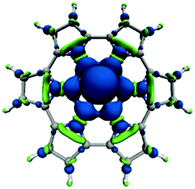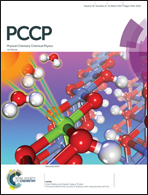Ligand size dependence of U–N and U–O bond character in a series of uranyl hexaphyrin complexes: quantum chemical simulation and density based analysis†
Abstract
A series of uranyl complexes with hexaphyrin ligands are investigated at the density functional level of theory and analysed using a variety of density-based techniques. A relationship is identified between the size of the ligand and the stability of the complex, controlled by the presence of meso-carbon centres in the porphyrin ring. The complex with the smallest ligand, cyclo[6]pyrrole, is found to have enhanced covalent character in equatorial U–N bonds as defined by the quantum theory of atoms in molecules (QTAIM), as well as enhanced stability, compared to the larger complexes. QTAIM data are supported by electron density difference distributions, integrated electronic properties and analysis of the reduced density gradient (RDG), which all show unambiguous evidence of electron sharing in all U–N bonds. In all complexes, a weakening of the covalent axial U–Oyl interaction in comparison to free uranyl is found, with evidence for a separation of electronic charge resulting in a more ionic interaction. A relationship between covalent character in the U–N bonds and the magnitude of uranyl charge redistribution is identified, where the greater the covalent character of the U–N interaction, the more ionic the U–Oyl interaction appears. The complex with the largest ligand, hexaphyrin(1.1.1.1.1.1), is found to have additional interactions with the uranyl oxygen centres, perturbing the U–Oyl interaction.



 Please wait while we load your content...
Please wait while we load your content...